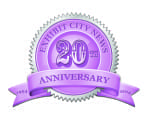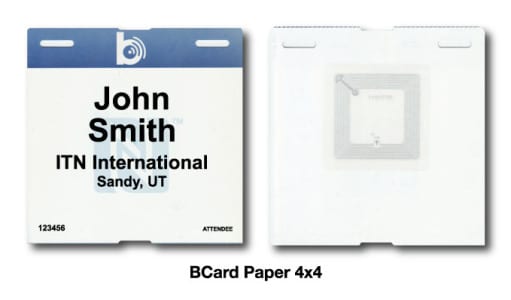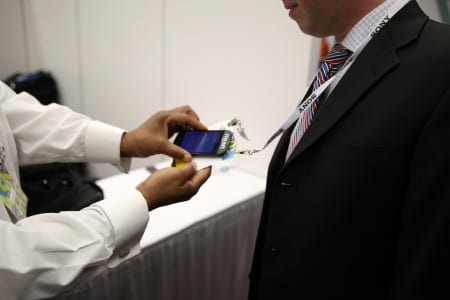 When new technology hits the shelves, or the tradeshow floor, there are common reactions: mourning from those affected and excitement from those who’ll benefit.
When new technology hits the shelves, or the tradeshow floor, there are common reactions: mourning from those affected and excitement from those who’ll benefit.
Mourning the death of old technology because newer equipment hammered the final nail into its coffin is an ever present part of society. As the previous way of doing things fades away, oftentimes, so do the jobs that supported it as well as a company’s revenue stream. Surviving technological shifts seems to involve companies becoming diversified enterprises, staying on the cutting edge and offering their customers other useful solutions.
On the other hand, innovative technology is embraced in and outside of the tradeshow industry. Many recognized this phenomenon after Apple released the first iPhone in 2007, and consumers chucked their older cellphones. Then the trend became chucking older iPhones in favor of the latest model, despite the prices. In the exhibitions industry, many tradeshows center on driving technological innovation to enhance business-to-business interactions. The Society of Independent Show Organizers (SISO) highlights breakthrough event technology through its SISO Event Innovation Battlefield.
For those sharing neither of these perspectives, there may be a lack of awareness – as could be the case with Near Field Communication (NFC). Not many people realize that the short-range technology provides opportunities to exchange information between devices, usually smartphones, or gain information by using an NFC-enabled smartphone near content embedded with NFC tags. Nor do many know it has been around for more than 10 years.
Despite NFC’s slow pace reaching handset manufacturers and non-technologically inclined individuals, ITN International President and CEO Ivan Lazarev predicts NFC has the power to cause mourning for what was as well as excitement for what can be.
If what he believes comes to fruition, NFC could potentially transform the way lead retrieval companies operate in another 10-plus years.
The role of NFC-enabled smartphones at future tradeshows
Constantly evolving, the smartphone has become an essential item no one leaves home without. In the future, the improved capabilities of smartphones due to the widespread implementation of NFC could render lead retrieval equipment unnecessary.
“Traditional badging as we know it will disappear. The evolution of the smartphone as a tool we use on a daily basis is no longer a question. We use it for texting, emails, loading boarding passes, etc. The digital badge will be contained in a smartphone,” explained Lazarev. “[Exhibitors] will no longer rent devices from registration companies. They won’t need registration companies to get contact data. Your phone belongs to you as a business professional and consumer.”
Lazarev imagines a future in which convention centers will provide badge check-in kiosks and rent space on them to show producers. Using NFC-enabled smartphones pre-loaded with digital badges, attendees would then interact with the kiosks to print their badges rather than show producers paying onsite registration companies to do this task.
Exhibitors owning an NFC-enabled smartphone could capture lead information from each attendee’s phone rather than renting lead retrieval equipment. Currently, NFC chips have larger storage capacities than Quick Response (QR) codes, and who knows how this storage could expand in the future?
Registration providers would still handle ticketing, selling conference programs and database management at convention centers, according to Lazarev. He added these companies would lose half of their revenue due to everyone owning and using NFC-enabled smartphones at tradeshows.
“Large [lead retrieval] companies will see something similar to what happened to travel agents when a big website came in and all the travel agents disappeared,” he stated. “We recognize this, and if we don’t raise the value proposition, we don’t have chance of surviving. It scares a lot of us, and it’s challenging, but we have to create enterprise solutions that exhibitors will want to purchase.”
What is NFC?
To truly understand how NFC could potentially impact lead retrieval companies, it’s important to know how the technology works.
A branch of Radio-Frequency Identification (RFID), NFC entered the development stage on Sept. 5, 2002. Created by NXP Semiconductors, previously known as Philips, and Sony, NFC chips were loaded with currency by the phone owner. Becoming digital wallets, smartphones enabled with NFC allowed users to tap them against NFC hotspots to transfer funds so they could buy groceries or bus tickets.
 It also works within 1 inch of another NFC-enabled device or hotspot. NFC tags on stationary items like posters allow individuals to experience one-way interactions. This short-range technology communicates by reading, writing or exchanging information or money.
It also works within 1 inch of another NFC-enabled device or hotspot. NFC tags on stationary items like posters allow individuals to experience one-way interactions. This short-range technology communicates by reading, writing or exchanging information or money.
After NFC came to America, many companies had already implemented it in a majority of devices in Asia and Europe. Currently, Europe and China enabled 75 percent of their smartphones with NFC chips. With the 60-40 ratio of NFC-enabled smartphones in the U.S., it begs the question – are more companies waiting for NFC to mature?
NFC Times reported in January 2013 that nine out of 10 of the largest handset makers support NFC — except Apple because the technology hasn’t matured. From the point of view of NFC Times writer Dan Balaban, Apple’s lack of interest in NFC may have affected the technology’s breakthrough.
Prior to the iPhone 6’s release in September 2014, rumors swirled that Apple would finally implement NFC chips to support mobile payments – a rumor Lazarev heard too. It turns out this wasn’t a rumor after all, probably an insider releasing knowledge about “Apple Pay.”
“Apple’s decision to include NFC in its iPhone 6 is a landmark for U.S. event producers,” he stated. “Apple has made NFC mainstream overnight. U.S. event producers are going to see a surge of new and important NFC applications as soon as open NFC in the iPhone is supported.”
Lazarev added that he thinks Apple delayed implementing NFC chips in its devices due to wanting the technology to complement its iBeacon software, an indoor proximity system that exchanges information between iPhones or sends one-way messages to Android phones.
Spending millions on research after realizing the power of touch-marketing interactions using smartphones, Nokia long committed to NFC, so has Samsung and other handset manufacturers. NFC World provides a full list: www.nfcworld.com/nfc-phones-list/.
ITN International brings NFC to U.S. tradeshows
Since opening in 1996, ITN International has led the way in offering mobile NFC and cloud-based event solutions.
The company was the first to bring NFC to U.S. tradeshows in 2007. At the time, the only shows ready for this technology were also technology based. The company regularly provides lead management services for Microsoft, Hewlett-Packard, CTIA and corporate events.
“At first, we purposely didn’t enter the American market because the industry wasn’t ready. It hit big five years ago. Our big claim to fame was switching barcodes to NFC at [International] CES,” stated Lazarev.
At its first American tradeshow, ITN International delivered 300 NFC-enabled smartphones to exhibitors.
“We saw an increase in leads collected by exhibitors. The quality of leads went up. When the exhibitor was done with a lead, it was uploaded to our portal where they could view [it],” he added.
Due to NFC taking years to gain traction, few U.S. lead management companies offer it. QR codes and barcodes are commonly seen at tradeshows. According to Lazarev, there was a time when QR codes weren’t available in America and widespread only in Europe and Asia.
Long-range RFID is occasionally used at tradeshows as it is an extensive and expensive operation, including antenna installation on the ceilings of a convention center. With a 90-95 percent precision rate of capturing information, according to Lazarev, RFID too had privacy flaws that NFC corrected.
“You have to have touch technology. In our industry, there are strong privacy laws. With long-range [RFID], it was hard to protect the privacy of individuals. If they don’t touch the NFC hotspot, it’s quite secure,” he explained.
To find out more about ITN International and its NFC-based event solutions, visit www.itnint.com/index.
































